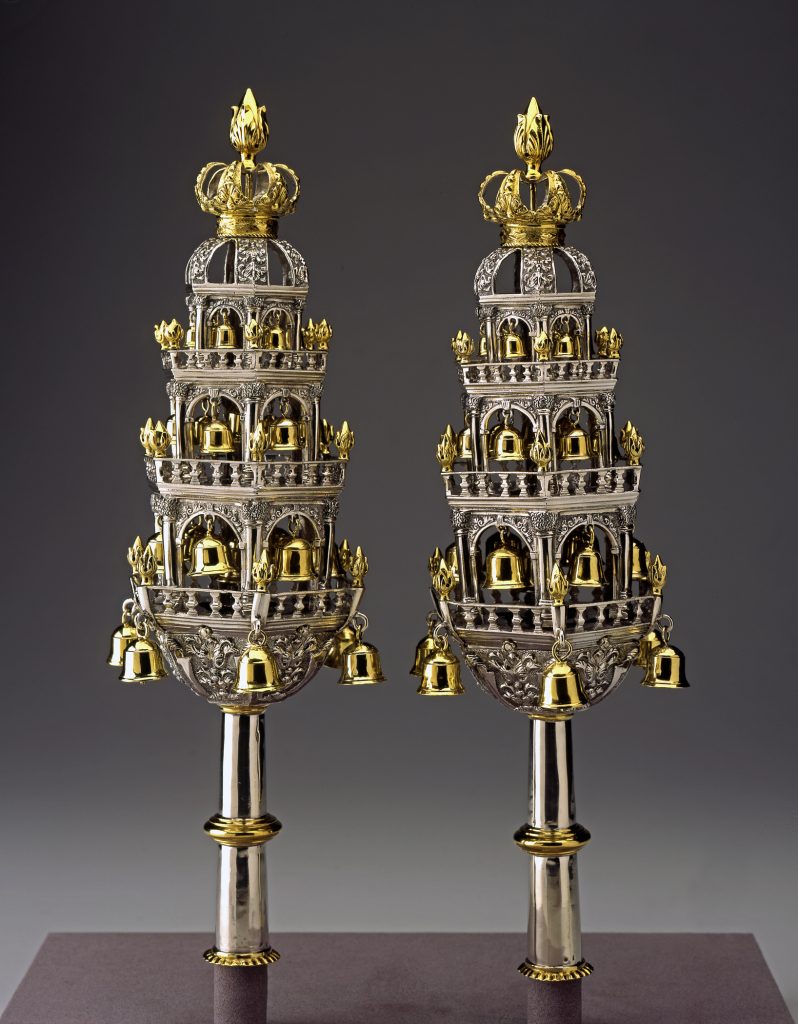Pair of Torah Finials (Rimmonim) (work of art)
Artwork Info
Key Ideas
- The finials (ribbonim in Hebrew) are designed in the form of a three-level hexagon, or object with six sides.
- The arched windows on the finials are decorated with bells and divided by columns. Both finials are mounted by a domed roof composed of six arches and a crown. A plant bud provides a knob at the very top.
- Each finial has a crown (keter in Hebrew) on top, symbolizing the sovereignty of the divine word.
- The bells on the finials and parts of the small crowns are gilded. Gilding is a centuries-old technique of covering a surface with a thin layer of gold.
- The bells on Torah finials serve a practical purpose. When the Torah scroll is taken out of the Ark, the scrolls are carried through the sanctuary. It is a custom to follow the scroll, or scrolls, as they are carried. The bells make it possible to hear the scroll (or scrolls) as they are being carried among the congregation and up to the bimah, or reading table.
Learn More
Willem Hendrick Rosier was admitted to the Amsterdam Goldsmiths’ Guild in 1725. Like most Dutch artisans of the period, Rosier was Christian. His Torah finials in the NCMA collection are one of only six pairs (attributed to him) that are known to exist.
Once part of the treasury of Amsterdam’s Grote Synagoge (Great Synagogue), these finials were looted by the Nazis during World War II. They were recovered after the war and returned to the Dutch Jewish community. Unfortunately the Great Synagogue never reopened, and the finials were eventually consigned to auction, where they were purchased by the NCMA in 2006.
These Torah finials, or rimmonim, resemble the architectural elements of the steeple on Amsterdam’s Oude Kerk (Old Church). The term “finials” describes the silver covers on the Torah’s staves, or wood handles. Finials are a common element used in architecture, furniture, and home decor. They can be made from a variety of materials, and they commonly appear on churches, schools, and homes. Finials are used on items such as fence posts, handrails, flag poles, and weathervanes. On furniture, finials are often used on bedposts, at the ends of curtain rods, and as decorative tops of cabinets. Finals come in many shapes and sizes, including spears, domes, steeples, fruits (such as pineapples), tree blossoms, and flower blooms.
tags: communication, function, pattern, repetition, ritual, sound
Additional Resources
Resources for Teachers:
- Learn more about the history of the Jewish communities in the Netherlands.
- View photographs of Oude Kerk Old Church Amsterdam and its steeple
- Learn more about Torah finials and all of the Torah ornaments.
Resources for Students:
- Read an article about the Nazi looting of art, property, and other valuables before and during World War II.
- Watch a short video about Rosier’s Torah finials.

